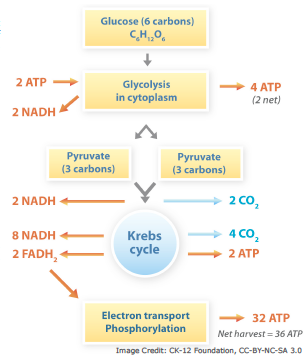PDF: A Study Guide
C6H12O6 + 6 O2 → 6 CO2 + 6 H2O + ATP
The general order of the processes is:
Realize that in general, the outputs of one process are the inputs of following processes. Knowing the inputs and outputs of each step is key to understanding cellular respiration!

Key Terms
Cellular Respiration: Process in which cells break down glucose and make ATP for energy.
Glycolysis: First stage of cellular respiration in which glucose is split, in the absence of oxygen, to form two molecules of pyruvate (pyruvic acid) and two (net) molecules of ATP.
Glucose: Simple carbohydrate with the chemical formula C6H12O6 that is the nearly universal food for life.
Pyruvic Acid (aka pyruvate): A 3-carbon molecule that results from the splitting of glucose.
ATP (adenine triphosphate): Energy-carrying molecule that cells use to power their metabolic processes.
ADP (adenine diphosphate): The molecule that re-sults from dephosphorylation (a phosphate group is removed).
Krebs Cycle: Second stage of aerobic respiration in which two pyruvate (pyruvic acid) molecules from the first stage react to form ATP, NADH, and FADH2.
NADH: Molecule that acts as an electron carrier in cellular respiration.
Electron Transport Chain (ETC): Series of electron-transport molecules that pass high-energy electrons from molecule to molecule and capture their energy.
Anaerobic Respiration: Type of cellular respiration that does not require oxygen.
Aerobic Respiration: Type of cellular respiration that requires oxygen.
Mitochondrion (plural, mitochondria): Organelle in eukaryotic cells that makes energy available to the cell in the form of ATP molecules.
Fermentation: A type of anaerobic respiration that allows ATP to be made through glycolysis.
Stage I: Glycolysis
The first step in cellular respiration is glycolysis, an anaerobic process. Glycolysis occurs in several steps to split glucose and make pyruvate, ATP, and NADH in the cytosol of the cytoplasm. Pyruvate is used for the Krebs cycle while NADH is collected for the electron transport chain.Stage II: Entering the Krebs Cycle
The next two stages of cellular respiration are aerobic processes that occur in the mitochondria.
Before the Krebs cycle, pyruvate is combined with an enzyme called CoA (Co-enzyme A) to form acetyl-CoA. Acetyl-CoA enters the Krebs cycle and combines with a four-carbon molecule to form citric acid.
A series of reactions releases energy from the carbon compounds, which is captured in molecules of FADH2, NADH, and ATP.
Glycolysis producese two pyruvic acids, so it takes two turns through the Krebs cycle to completely breakdown the original glucose.

Stage III: Electron Transport Chain and ATP Synthase
In the electron transport chain (ETC), FADH2 and NADH molecules from the Krebs cycle are oxidized. The oxidation of the electron carriers (NADH and FADH2) produces H+ ions and electrons.ETC is an aerobic process, as it requires oxygen molecules to attract and combine with the electrons at the end of the ETC to make water.
Cellular Respiration: Per Glucose
| Inputs | Outputs | Net Gain (per each process) |
|
|---|---|---|---|
| Glycolysis | 1 Glucose 2 ATP |
2 Pyruvates 4 ATP 2 NADH |
2 Pyruvates 2 ATP 2 NADH |
The Krebs Cycle |
2 Acetyl-CoA |
2 ATP 8 NADH 2 FADH2 |
2 ATP 8 NADH 2 FADH2 |
| Electron Transport Chain | 10 NADH 2 FADH2 |
34 ATP |
34 ATP |
| Total Molecules of ATP | 38 ATP |
Anaerobic Respiration

Aerobic vs. Anaerobic Respiration
Aerobic respiration advantages:Anaerobic respiration advantages:
• Produces ATP very quickly
Fermentation
Lactic acid fermentation:

Alcoholic fermentation:

